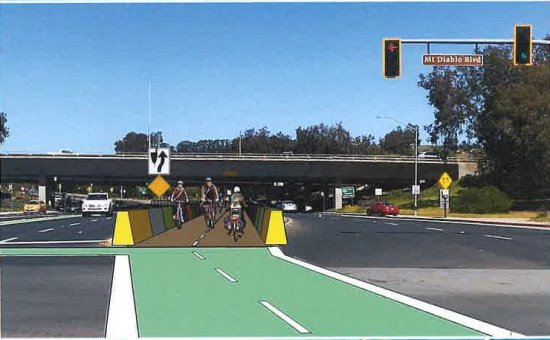
| ||||||
The proposed projects included: "Synthetic Turf for City Fields" ($2.5 million); "West Reach Creeks" ($900,000); designs for the "Pedestrian & Bicycle Pathway Along the EBMUD Aqueduct Right-of-Way in Downtown Lafayette" ($675,000); and "Pleasant Hill Road Pathway to Acalanes High School ($4.3 million).
According to the staff report presented by City Manager Niroop Srivatsa, installing synthetic turf in local city fields would save water, reduce maintenance costs, create (wild) pig proof fields, and allow for increased youth sport opportunities, notably, sports actives which are currently underserved.
Parks and Recreation Director Jonathan Katayanagi clarified the benefits of adding turf and lights to city fields, noting that additional lighting would maximize the hours made available to sports teams and clubs. Several council members and members of the public noted concerns that artificial turf requires continuous repair and care, has potential environmental impacts, could cause injuries to athletes, and comes with no guarantee it will deter the pig invasions that have haunted local fields during the last few years.
The creeks project would stabilize the banks of Lafayette Creek, restore native riparian wildlife habitat, and serve as a vehicle to educate the public about climate change-related resilience.
The designs for a pedestrian and bicycle pathway along the aqueduct that would ultimately provide a low-stress pedestrian and bicycle right-of-way through Lafayette's downtown were a "new ask" added to the list to support what the report said is "a vibrant area that includes a mix of residential, public transit, commercial, educational and institutional land uses."
The Pleasant Hill Road pathway project involving funding for a multi-use pathway down the center of Pleasant Hill Road between Mt. Diablo Boulevard and Deer Hill Road/Stanley Boulevard would, according to the staff report, advance safe routes to school, reduce automobile trips and emissions, increase user safety - a claim that received considerable, broad-based pushback during public comments - and complete a regional bikeway and walkway network.
Pleasant Hill Road is a major arterial that can serve up to 36,000 vehicles per day. It is a connector to Highway 24 on-ramps and off-ramps and located immediately south of Acalanes High School and Springhill Elementary School. Pedestrians and bicyclists currently need to cross the freeway on-ramps and off-ramps when commuting to either school.
The project's design is underway and if completed, would close a gap between northeast, central, and southern Lafayette and connect to the East Bay Regional Park District's Lafayette-Moraga Regional Trail. The pathway would be 14 feet wide and separated from vehicle traffic by vertical concrete barriers on either side. In order to accommodate this design, the parking on Pleasant Hill Road between Mt. Diablo Boulevard and Stanley Boulevard / Deer Hill Road and the existing dedicated northbound right turn from Pleasant Hill Road to Stanley Boulevard would be eliminated. The city's website emphasizes in a project overview that no decision has been made about preserving or eliminating the right turn lane while the pros and cons of two options continue to be evaluated.
During public comment, residents spoke overwhelmingly about three issues: installing synthetic turf at ballparks, the need for a usage survey on the proposed Acalanes bike path, and the council's "rush-to-decide" timing they said did not allow for adequate study and public input to take place.
Lauren Herpich said, "No one wants to see the Pleasant Hill and dedicated bike and pathway project done." She believes funding requests should shift and be aimed at furthering the Safe Routes to Schools projects that have already been vetted.
Brad Rosenthal highlighted the bike path on Pleasant Hill Road and suggested a lack of studies had been done regarding safety and, especially, the impact the project would have that is related to additional traffic. The other path project, near the EBMUD aqueduct, he said, is in a high water table area and, especially with the exacerbated difficulties during rainy years like the current one, warrants more attention. Rosenthal questioned the path's usage because it would benefit only certain parts of the area and therefore more studies must be conducted.
Carol Singer raised a practical point and said students at Acalanes High School should be involved in the discussion about the multi-use pathway on Pleasant Hill Road.
Others requested more community meetings be held about Pleasant Hill Road issues and questioned an engineer's reports and statements they said inaccurately assessed the cost of an alternative pedestrian overpass that had been submitted by a Lafayette resident. (Design plans for the alternative project, in addition to safety and usage features, has a budget of $3 million, versus the city's $4.3 million project.) Several people said the Pleasant Hill Road report was rushed, lacked sufficient study, and failed to give serious consideration to alternatives proposed by Lafayette citizens. More than one person proposed using funding for projects that are already under way, such as road striping and other elements in the Safe Routes to School project that are still unfunded years after they were initiated.
In response to residents' concerns regarding short time frames, the city manager suggested developing a calendar for future years so council members will consider projects well in advance of having to make decisions. Her idea received strong support from the city council.
The council decided unanimously to put forward three of the four projects: The play field turf and lights; the pedestrian and bicycle pathway along the EBMUD aqueduct; and the West Reach Creeks project. If Parks and Recreation staff, after further study, decide they do not want to proceed with installing artificial turf, council will decline any funds applying to turf.
The Pleasant Hill Road Pathway was pulled to allow more time for studies to be conducted and to fully consider the significant public input.
Reach the reporter at:
